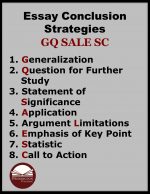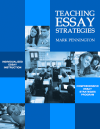Essay Conclusion Response Comments
Fair to say that the essay conclusion tends to be the weakest instructional piece of our essay teaching repertoire. The full extent of my own high school English instruction regarding this essay component was “Re-state the thesis, sum up the essay main points, and give a finished feel to the essay.” Not much help and not much thinking required of the writer with those instructions!
For good and bad, most teachers teach as they were taught (or not). True, we do pick up a few things along the way… Early in my teaching career, I attended a writing workshop or read a book encouraging the teaching of a “Call to Action” in the conclusion paragraph. A revelation to me and to my fellow English teachers… something concrete I could teach to my students and a strategy that actually required some thinking! Unfortunately, English teachers square pegged that one to death. I remember an English teacher assigning a response to literature essay analyzing the themes of Moby Dick and requiring a “Call to Action” as part of the conclusion. Made absolutely no sense.
To my knowledge I’ve never met a teacher who said she remembers learning specific conclusion strategies in undergrad or grad school English composition classes. Nothing in Strunk’s Elements of Style on essay conclusions, either. We all tend to devalue what we don’t understand or experience and esteem that which we easily comprehend and practice. For example, I came across the same set of instructions when grading state writing exams a number of years ago. I was surprised in discussing the scoring rubric that a student could achieve a perfect 6 score without including a conclusion. Clearly, these test-writers did not appreciate the value of the essay conclusion.
As a teacher, I’ve found that most of my colleagues do an admirable job of teaching essay and paragraph structure, especially how to dissect a writing prompt, how to write an effective thesis statement, and how to compose body paragraphs. However, the teaching of the introduction strategies (the hooks) and the conclusion strategies receive short shrift. My guess is that teachers have little knowledge and experience about these essay components, and so they focus on what they know, have done, and can teach best.
But we do have other models of how the essay conclusion can be an essential ingredient to the essay. Talk to any upper elementary, middle, or high school science teacher about the role that conclusions play in the scientific method. The conclusions in science lab reports come to mind: a true analysis of the observations; commentary on the experimental design; verification of the hypothesis; suggestions for related research and experimentation.
I say let’s re-focus our attention on the essay conclusion. Let’s broaden the opportunities for students to reflect and provide meaningful analysis and application of the evidence, argument, and/or information presented in the body paragraphs. Let’s encourage students to not just re-state the thesis (Do so… the audience expects it!), but also to analyze the degree to which they were able or unable to prove their purpose or point of view.
Check a related article on How to Teach the Essay Conclusion for a variety of conclusion strategies. Also, look at the targeted comments I’ve developed for all components of the essay, including conclusion paragraphs. They are the same kinds of comments you’d type up and program if you took the time to do so. Learn how to use these comments to respond to first or second drafts, and not just as summative comments on the final draft.
I’ve developed 438 of the most common comments teachers make to respond to student essays. Comments are categorized and given a simple alphanumeric code to access a downloaded comment.
Examples:
e46 Needs Thesis Re-statement Essay conclusions traditionally begin with a thesis re-statement. Consider using a different grammatical sentence opener or opening transition word to avoid repetition.
e47 Needs Another Conclusion Strategy Use at least two conclusion strategies. Add a Generalization, Question for Further Study, Statement of Significance, Application, Argument Limitations, Emphasis of Key Point, Summary Statement, or Call to Action. GQ SALE SC
e48 Needs a Different Conclusion Strategy Use a variety of conclusion strategies. Add a Generalization, Question for Further Study, Statement of Significance, Application, Argument Limitations, Emphasis of Key Point, Summary Statement, or Call to Action. GQ SALE SC
e49 Needs a Finished Feeling A conclusion needs to provide a finished feeling for the reader. The conclusion must satisfy the reader that the purpose has been achieved or point of view has been convincingly argued.
As we all know, many of the same comments will apply to most students. How many times have we veteran English teachers written out this comment in an essay conclusion: “Don’t introduce new evidence in the conclusion”? 1000? One smart solution would be to develop a bank of most-often used essay comments to help students revise all areas of the essay:
Introduction Paragraphs, Body Paragraphs: Argument, Analysis, Evidence, Conclusion Paragraphs, Coherence, Word Choice, Sentence Variety, Writing Style, Format, Textual Citations, Parts of Speech, Subjects and Predicates, Types of Sentences, Mechanics, and Conventional Spelling Rules
I’ve developed 438 of the most common comments teachers make to respond to student essays. Comments are categorized and given a simple alphanumeric code to
access a downloaded comment (See above examples). Using e-comments to insert into online student essays submitted on Microsoft Word or in Google Docs can save grading time and allow teachers be selective, prescriptive, and efficient. Of course, many teachers prefer to copy and paste these comments and then print off a comments for each student. Teachers can then hold students accountable for revision.
Works great in Microsoft Word and can be batch dumped easily into Google Docs. Nice for paper comments as well. The comments use the same, consistent language Common Core language of instruction. I’ve included this comment download in my TEACHING ESSAYS BUNDLE and The Pennington Manual of Style (a slice of the comprehensive essay program).


